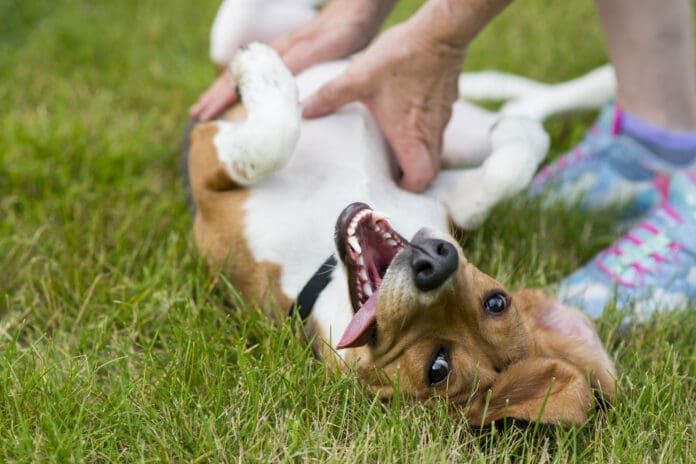You walk in the door after work and you’re greeted by your dog wildly wriggling and wagging, then flopping onto his back with his paws joyously waving in the air, tongue lolling out with a goofy smile on his face. Who could resist bending down to give that pup a belly a rub or two? But have you ever thought about why many dogs like belly rubs so much?
But have you ever thought about why your dog seems to like belly rubs so much? I know why I like to give them: the belly fur is generally the softest and silkiest, and caressing it simply feels wonderful. That begs the question: does my dog like it just as much?
It turns out the answer is yes…and no. It depends upon the dog, the situation, and who’s doing the rubbing.
The Science Behind Why Dogs Like Belly Rubs
First, let’s talk about what we know, as opposed to what we think. Numerous research studies both here and abroad have shown that just a few minutes of petting can increase a dog’s oxytocin, a powerful endorphin linked to feelings of pleasure and happiness; at the same time, the level of cortisol—the hormone that triggers stress—decreases. (It won’t come as a surprise to most of you that the “petter” enjoys similar benefits!)
The same physiological mechanism applies to giving your dog a belly rub. Rubbing or stroking your dog’s belly instantly activates the scores of very sensitive nerves and sensory neurons, known as touch receptors, on her abdominal region. Not to go too Sandy Scientific on you, but these touch receptors travel along sensory nerves that connect to neurons in the spinal cord, then to the thalamus, and finally to the somatosensory cortex of the brain, which in turn triggers the release of oxytocin. All this happens in the flutter of an eyelash: the only thing we’re aware of is that our dog goes into a state of semi-bliss the moment we start rubbing her belly.
That being said, while science knows why dogs like being petted in general, there are no research studies on why dogs like belly rubs in particular. But for all intents and purposes, petting is petting, no matter where it’s done. It’s simply another way for dogs to bond with us, and we with them. Dr. Annette Louviere, DVM at Wisdom Panel, says that petting your dog, no matter where on the body, can be a form of communication between the two of you that acts as a bond. Dr. Stanley Coren, author of How to Speak Dog, concurs: “For some dogs, a belly rub is simply a variant of being petted. It is a form of social contact.”
Why Do Dogs Roll on Their Backs To Begin With?
Generally, there are two reasons why dogs roll on their backs: first is that they’re angling for affection and a belly rub. But don’t assume that a dog on his back automatically wants that: sometimes it’s a submissive gesture where the dog wants to appease you or another dog. Again, look at their body language: if the dog is ducking or leaning away, licking her lips, her ears are back, and she’s avoiding looking at you, those are sure signs that she doesn’t want to be touched. If you try to give a belly rub to a dog who is presenting her underside as a form of appeasement, she’ll probably become even more nervous or uneasy, and will do her best to get away.
On the other hand, if your dog’s body is loose and waggling, his mouth is open in what looks like a grin, his tail is relaxed and even thumping on the floor, you can almost bet the farm that he’s ready for a belly rub.
Do All Dogs Like Belly Rubs?
I’ve never had a dog that didn’t become positively delirious over getting a belly rub, but then, all my dogs have been Golden Retrievers, a breed that’s renowned for being pushovers for attention and affection. That being said, not every dog likes belly rubs. Remember that the belly is the most vulnerable spot on a dog’s body and some dogs may feel uncomfortable—or even threatened–when exposing their undersides.
Breed, genetics, and early life experiences can all govern whether or not a dog enjoys the intimacy of a belly rub. And even a dog that loves them won’t want them all the time or in every circumstance. (As much as you enjoy swimming, would you want to do it every day of the year, even when it’s 20 degrees outside?) Just like humans, every dog is different, with different likes, dislikes, and personality quirks. It’s up to us as their caretakers to learn how to read their body language so we’ll know what’s pleasurable for them and what isn’t.
Why Do Dogs Kick Their Legs When You Scratch Them?
Chances are, you’ve seen this, or experienced it with your own dog. You’re giving him a nice, energetic belly rub, when suddenly one of his back legs starts kicking. What’s going on?
It’s called the scratch reflex, an instinctive, evolutionary response that allows an animal to get rid of bugs or irritants. Lore Haug, a veterinarian and animal behavior expert for Texas Veterinary Behavior Services, explains that dogs developed the scratch reflex as a way to defend against annoyances like invading bugs like fleas or ticks. The kicking is an attempt to dislodge the source of irritation, knock off some of the bugs, and relieve the itch.
There’s a collection of nerves located just under the skin that makes up the spot on a dog’s body that triggers the scratch reflex when he is rubbed or scratched: this is called the “sweet spot” or the “tickle spot.” Most often, this spot is somewhere on the belly or flank area, so when you rub your dog’s tummy and hit this spot, the nerves get activated and send a message to the hind leg to start kicking.
We don’t know for certain whether this reflex action is pleasant or unpleasant for the dog: like people who are ticklish, dogs can find tickles to be either enjoyable or infuriating. Watch your dog’s body language to see if he’s having as much fun kicking as you are when you’re watching him kick: if he pulls away or tries to turn over, he’s letting you know the fun is over.
So next time your dog rolls over on her back and gives you a big, silly smile, rub away!






